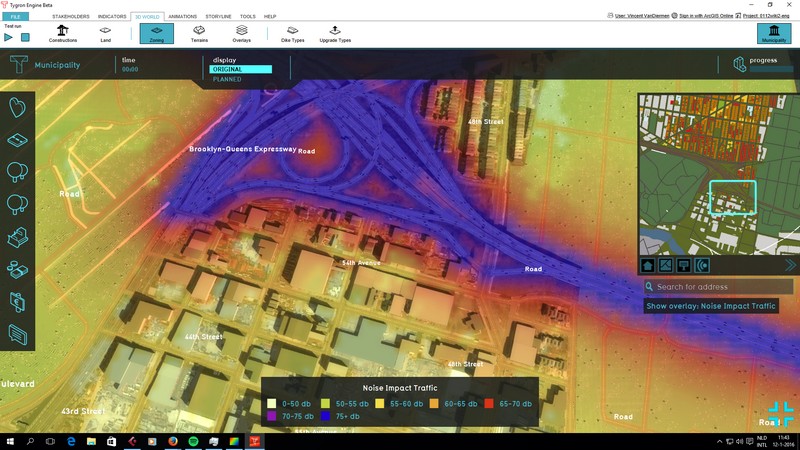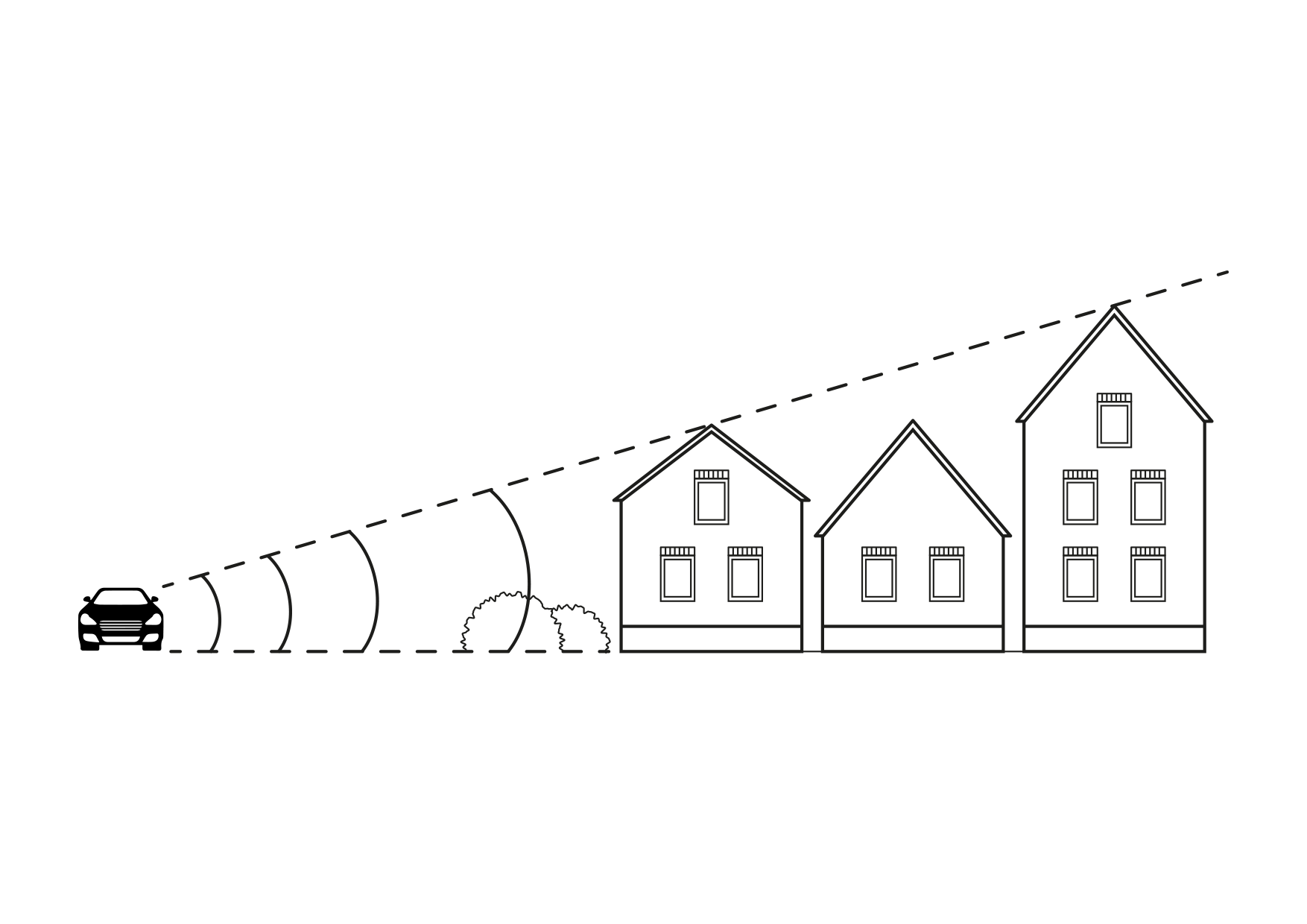Traffic Noise Overlay: Difference between revisions
m (Undo revision 44634 by Rudolf@tygron.nl (talk)) |
mNo edit summary |
||
| Line 1: | Line 1: | ||
[[File:Traffic_Noise-Overlay.jpg|thumb| | |||
The Traffic Noise Overlay is an [[Grid Overlay]] which displays the impact of traffic noise in DB(A) for the project area. Based on [[Traffic Flow (Overlay)|traffic flow]], distance and several computation parameters a grid is calculated for the project area. Note, this overlay only shows the impact of traffic noise on top of a background value of 48 dB(A). Influence of other sources (e.g. windmills, air traffic, factories, etc) is excluded.<br> | [[File:Traffic_Noise-Overlay.jpg|thumb|right|Traffic Noise overlay]] | ||
The Traffic Noise Overlay is a [[Grid Overlay]] which computes the amount of noise in Db(A) for any give location in the [[3D World]]. The calculation takes into account traffic intensities and a number of environmental- and computation parameters to compute the noise impact. It also takes into account [[Construction|object]]s and [[Elevation model|terrain features]] which would block the transmission of noise. | |||
The Overlay only computes noise from traffic. Although a background noise level can be configured, other sources of noise (such as windmills, air traffic, or factories) are explicitly excluded. | |||
{{clear}} | |||
<!-- | |||
==Configuration== | |||
==Calculation== | |||
==Results== | |||
{{article end | |||
|references= | |||
* The overlay calculations are based on Standard Calculation Method 1 (SRM1) as defined by the dutch government: [http://wetten.overheid.nl/BWBR0031722/2015-07-01#BijlageIII wetten.overheid.nl] | |||
|howtos= | |||
* [[How to add and remove an Overlay]] | |||
* [[How to edit an overlay legend]] | |||
}} | |||
{{Overlay nav}} | |||
The Traffic Noise Overlay is a [[Grid Overlay]] which displays the impact of traffic noise in DB(A) for the project area. Based on [[Traffic Flow (Overlay)|traffic flow]], distance and several computation parameters a grid is calculated for the project area. Note, this overlay only shows the impact of traffic noise on top of a background value of 48 dB(A). Influence of other sources (e.g. windmills, air traffic, factories, etc) is excluded.<br> | |||
It becomes available for all stakeholders when added to a project. | It becomes available for all stakeholders when added to a project. | ||
<br clear=all> | <br clear=all> | ||
--> | |||
==Calculations== | ==Calculations== | ||
The calculations follow the standard rekenmethode 1 (SRM 1), as described on [http://wetten.overheid.nl/BWBR0031722/2015-07-01#BijlageIII]: | The calculations follow the standard rekenmethode 1 (SRM 1), as described on [http://wetten.overheid.nl/BWBR0031722/2015-07-01#BijlageIII]: | ||
| Line 60: | Line 88: | ||
* [[How to add and remove an Overlay]] | * [[How to add and remove an Overlay]] | ||
* [[How to edit an overlay legend|Edit an overlay legend]] | * [[How to edit an overlay legend|Edit an overlay legend]] | ||
{{Template:Overlay nav}} | {{Template:Overlay nav}} | ||
Revision as of 15:04, 10 February 2022
The Traffic Noise Overlay is a Grid Overlay which computes the amount of noise in Db(A) for any give location in the 3D World. The calculation takes into account traffic intensities and a number of environmental- and computation parameters to compute the noise impact. It also takes into account objects and terrain features which would block the transmission of noise.
The Overlay only computes noise from traffic. Although a background noise level can be configured, other sources of noise (such as windmills, air traffic, or factories) are explicitly excluded.
Calculations
The calculations follow the standard rekenmethode 1 (SRM 1), as described on [1]:
LAeq = E + Co + Cr - Da - Dl - Db - Dm
where:
- LAeq: equivalent noise level (dB(A))
- E: emission
- Co: acceleration term (default = XXX dB(A))
- Cr: reflection term (omitted)
- Da: distance reduction
- Dl: air reduction (default = XXX dB(A))
- Db: surface reduction (default = XXX dB(A))
- Dm: meteorological reduction (default = XXX dB(A))
Default values are taken from InfoMil [2]
Emission
Emission is computed as:
E = 10 * log(10^(Elv/10)+10^(Emv/10)+10^(Ezv/10)
Per vehicle category, the emission is computed as:
Em = am + bm * log(m/v0) + 10 * log(Q/vm)+Cw;m
and
Cw;m = σm + τm x log(vm/v0,m)
where:
- m: vehicle category (light weihgt, medium weight and heavy)
- a and b: factors to be found at InfoMil [3]
- Cw = road surface correction
- σ = correction factor at reference traffic speed
- τ = correction factor per 10 km/hour deviation from reference traffic speed
Distance reduction
Distance reduction is computed as:
Da = 10 * log(r)
where:
- Da: distance reduction
- r: shortest distance between the source and point of evaluation
References
The overlay calculations are based on Standard Calculation Method 1 (SRM1) as defined by the dutch government: wetten.overheid.nl
How-to's

